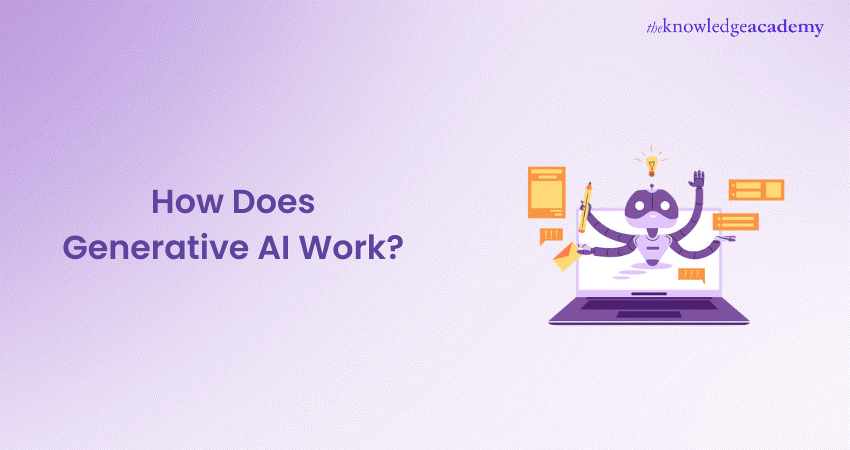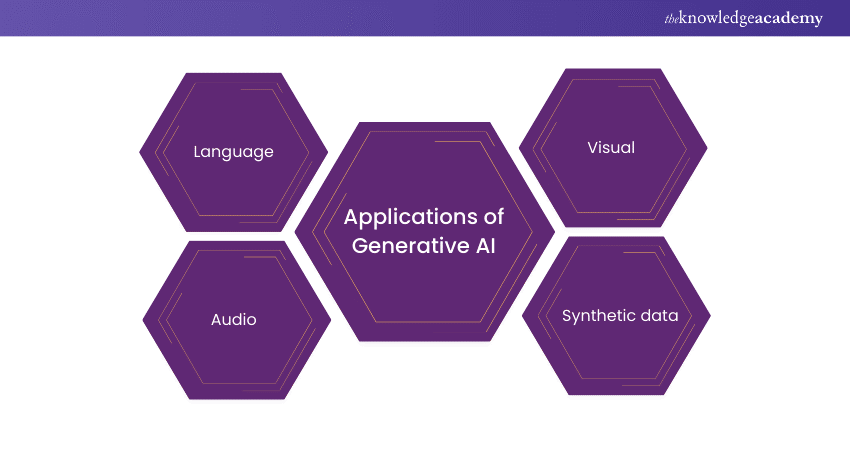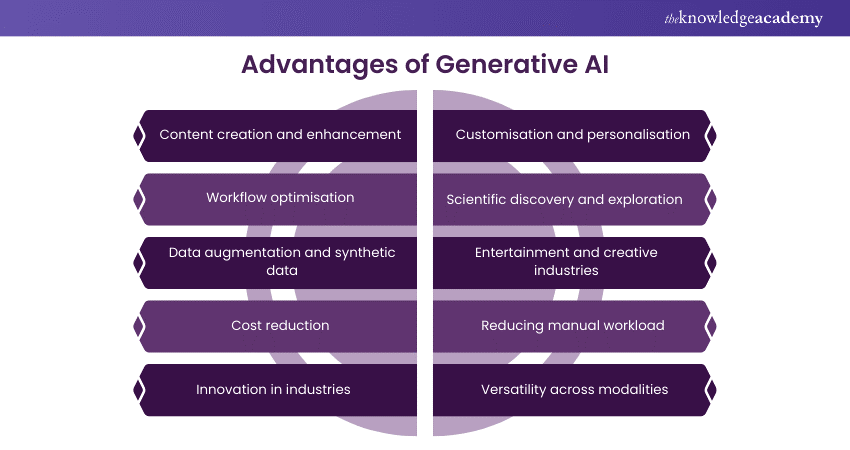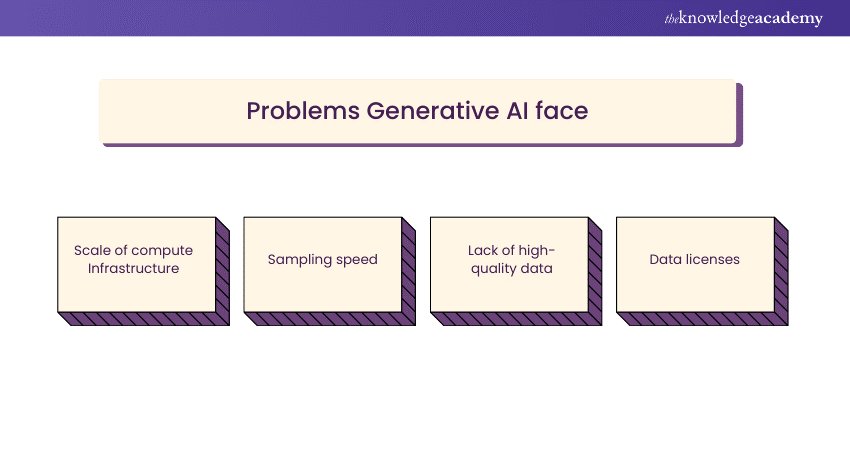We may not have the course you’re looking for. If you enquire or give us a call on +44 1344 203 999 and speak to our training experts, we may still be able to help with your training requirements.
Training Outcomes Within Your Budget!
We ensure quality, budget-alignment, and timely delivery by our expert instructors.

Nowhere is the creative alliance between man and machine more pronounced than in the field of Generative AI. From creating art and writing stories to even composing music, Generative AI has emerged not as mere technology but as a digital polymath! This blog examines How Generative AI Works and explores how it is transforming a vast range of industries. Read on to learn more!
Table of Contents
1) What is Generative AI?
2) How Does Generative AI Work?
3) How are Generative AI Models Developed?
4) Applications of Generative AI
5) Advantages of Generative AI
6) Problems Generative AI Face
7) Conclusion
What is Generative AI?
Generative AI is an Artificial Intelligence (AI) that can produce content such as video, images, audio, text, code, and other data. While previous AI algorithms were used to identify patterns within a data set and make predictions, Generative AI leverages Machine Learning (ML) algorithms to generate outputs based on a training data set.
Generative AI can produce outputs in the same medium in which it is prompted (e.g., text-to-text) or in a medium different from the given prompt (e.g., text-to-audio, text-to-image or image-to-video). Famous examples of Generative AI include Midjourney, ChatGPT, Gemini, DALL-E, and Perplexity, among others.
How Does Generative AI Work?
Generative AI begins with a prompt in the form of a text, an image, a video, a design, musical notes, or any input that the AI system can process. AI algorithms then generate new content in response to the prompt. This content can range from essays and solutions to problems to realistic fakes created from pictures or audio of a person, showcasing the diverse capabilities of Generative AI.
Early versions of Generative AI needed data to be submitted via an API or an otherwise complicated process. Developers had to familiarise themselves with a variety of tools and write applications using programming languages such as Python. Now, pioneers in Generative AI are developing superior user experiences (UX) that let you input a request in plain language. After an initial response, you can customise the results with feedback about the tone, style, and other aspects that you want the generated content to reflect.
Stay ahead of the learning curve with our Artificial Intelligence Tools Training!
How are Generative AI Models Developed?
In generative models, there exist various types, each possessing distinctive attributes. Combining the positive aspects of these models enhances the capability to create more potent generative models.
The following provides a detailed account of How Generative AI models are developed:
Diffusion Models
a) Also referred to as Denoising Diffusion Probabilistic Models (DDPMs), diffusion models are a type of generative model. During training, these models determine vectors in latent space through a two-step process: forward diffusion and reverse diffusion. In the forward diffusion process, random noise is gradually added to training data, and in the reverse process, the noise is reversed to reconstruct the data samples. Novel data can be generated by initiating the reverse denoising process from entirely random noise.
b) Although diffusion models may take longer to train compared to Variational Autoencoder (VAE) models, their two-step process allows for the training of hundreds, if not an infinite number, of layers. Consequently, diffusion models generally yield the highest-quality output in building Generative AI models.
c) Diffusion models are classified as foundation models due to their large-scale nature, high-quality outputs, flexibility, and suitability for generalised use cases. However, the reverse sampling process makes running foundation models slow and time-consuming.
Variational Autoencoders (VAEs)
a) VAEs consist of two neural networks known as the encoder and decoder. When provided with an input, the encoder transforms it into a smaller, denser data representation. This compressed representation retains the necessary information for the decoder to reconstruct the original input data, discarding irrelevant information. The encoder and decoder collaborate to learn an efficient and straightforward latent data representation, facilitating the easy sampling of new latent models for generating novel data.
b) While VAEs can generate outputs, such as images, more quickly, the generated images are not as detailed as those produced by diffusion models.
Generative Adversarial Networks (GANs)
a) GANs were widely used before the recent success of diffusion models. GANs involve two neural networks—a generator generating new examples and a discriminator learning to distinguish between real and generated content. Both models are trained simultaneously, improving iteratively as the generator produces better content, and the discriminator becomes more adept at determining generated content. This iterative process continues until the generated content becomes indistinguishable from existing content.
b) Although GANs can quickly produce high-quality samples, their weak sample diversity makes them more suitable for domain-specific data generation.
c) In the development of generative models, the underlying architecture is crucial. One popular architecture is the transformer network, which is particularly relevant in the context of Generative AI.
Transformer Networks
a) Like recurrent neural networks, transformers process sequential input data non-sequentially. Two mechanisms, self-attention and positional encodings, make transformers especially adept for text-based Generative AI applications. Self-attention assigns a weight to each part of an input, signifying its importance in the context of the rest of the input. Positional encoding represents the order in which input words occur.
b) A transformer comprises multiple blocks or layers, including self-attention layers, feed-forward layers, and normalisation layers, working together to decipher and predict streams of tokenised data, such as text, protein sequences, or image patches.
Understand the role of GANs, VAEs and other models for threat detection with our Generative AI in Cybersecurity Training!
Applications of Generative AI
Generative AI is a potent instrument for optimising the workflows of a diverse range of professionals, including creatives, engineers, researchers, scientists, and more. Its applications and potential are ubiquitous across various industries and individual pursuits.
Generative AI models can receive input in text, image, audio, video, and code, producing new content in any of these specified modalities. For instance, it can transform textual inputs into images, convert images into musical compositions, or transcribe videos into written content.
The following are the key applications of Generative AI which have garnered considerable popularity:

a) Language: Text is the foundation for numerous Generative AI models, with Large Language Models (LLMs) standing out as prime examples in this domain. LLMs find application in essay generation, code development, translation, and comprehending genetic sequences.
b) Audio: Music, audio, and speech are emerging frontiers in Generative AI. Examples include models generating songs and audio snippets based on text inputs, identifying objects in videos and generating corresponding sounds, and even crafting custom music.
c) Visual: Generative AI is widely employed in creating images, spanning 3D visuals, avatars, videos, graphs, and other illustrations. Its versatility allows for generating images with varied aesthetic styles and techniques for editing and modifying the produced visuals. Generative AI models contribute to creating graphs illustrating new chemical compounds, generating realistic images for virtual or augmented reality, designing 3D models for video games, crafting logos, editing existing images, and more.
d) Synthetic Data: Synthetic data proves invaluable for training AI models when data is unavailable, restricted, or inadequate in addressing specific scenarios with utmost accuracy. Generative models play a pivotal role in generating synthetic data, offering a solution to the data challenges faced by many enterprises. This extends across modalities and use cases through a process known as label-efficient learning. Generative AI models help reduce labelling costs by automatically producing additional augmented training data or learning an internal representation of the data that facilitates training AI models with less labelled data.
The impact of generative models is far-reaching, with applications continually expanding. The following are just a few instances highlighting how Generative AI propels advancements and transformations in transportation, natural sciences, and entertainment.
a) In the automotive sector, Generative AI is poised to facilitate the creation of 3D environments and models for simulations and car development. Synthetic data also plays a crucial role in training autonomous vehicles, enhancing safety, efficiency, and flexibility in road testing while mitigating risks and overhead.
b) The field of natural sciences experiences significant benefits from Generative AI, particularly in healthcare. Generative models aid medical research by generating new protein sequences to expedite drug discovery. Automating tasks such as scribing, medical coding, medical imaging, and genomic analysis further enhances practitioners' efficiency. In the weather industry, generative models create simulations for accurate weather forecasting and predicting natural disasters, fostering safer environments and enabling better preparation.
c) Across the entertainment industry, from video games to film, animation, world-building, and Virtual Reality, Generative AI models prove invaluable in streamlining content creation processes. Creators leverage generative models as tools to enhance their creativity and workflow.
Acquire skills in requirements elicitation documentation for validation implementation with our Generative AI For Business Analyst Training today!
Advantages of Generative AI
Generative AI offers a multitude of advantages across various fields and industries. The following are some key advantages:

Content Creation and Enhancement
a) Diversity in Output: Generative AI can produce diverse and novel content across different modalities, such as text, images, audio, and video, allowing for creative exploration and innovation.
b) Aesthetic Flexibility: In visual applications, generative models can generate images with different aesthetic styles, aiding artists and designers in exploring various creative directions.
Workflow Optimisation
a) Time Efficiency: Automating content creation processes with Generative AI can significantly reduce the time required for tasks like image generation, text creation, or code development.
b) Resource Optimisation: Generative models can enhance efficiency by reducing the need for extensive manual labour, enabling professionals to focus on higher-level tasks.
Data Augmentation and Synthetic Data
a) Improved Training: Generative AI can create synthetic data to augment training sets, especially when obtaining real-world data is challenging. This improves the robustness and generalisation of Machine Learning (ML) models.
b) Addressing Data Gaps: Generative models help address data gaps by generating data for scenarios that may be rare or difficult to capture in the real world.
Cost Reduction
a) Labelling Costs: Generative AI models can reduce the costs associated with manual data labelling by generating additional augmented training data, making machine learning (ML) projects more cost-effective.
b) Resource Efficiency: The ability to generate realistic data for simulations and testing reduces the need for expensive physical prototypes or extensive field testing.
Innovation in Industries
a) Automotive Industry: Generative AI contributes to creating 3D models for simulations, aiding in the development of autonomous vehicles and improving safety testing in realistic virtual environments.
b) Healthcare: In medical research, generative models can assist in the discovery of new drug candidates by generating novel protein sequences. Automation of medical tasks also enhances the efficiency of healthcare practitioners.
Customisation and Personalisation
Tailored Solutions: Generative AI can create personalised content, such as custom music, tailored images, or individualised recommendations, enhancing user experiences (UX) in various applications.
Scientific Discovery and Exploration
Natural Sciences: In fields like chemistry, generative models can suggest new chemical compounds, while in weather forecasting, they contribute to creating realistic simulations for accurate predictions and disaster preparedness.
Entertainment and Creative Industries
Content Generation: Generative AI is employed in creating content for video games, films, animation, and virtual reality, aiding creators in generating diverse and engaging experiences.
Reducing Manual Workload
Automation of Repetitive Tasks: Generative AI automates repetitive tasks such as data generation, allowing professionals to focus on higher-level problem-solving and Decision-Making.
Versatility Across Modalities
Multimodal Applications: Generative models can process and generate content across various modalities, including text, images, audio, and video, making them versatile tools in diverse applications.
Problems Generative AI face
As a developing field, generative models are still in their early stages, offering potential growth in several key areas.

Scale of Compute Infrastructure
Generative AI models can feature billions of parameters, necessitating swift and efficient data pipelines for training. Sustaining and advancing generative models demands substantial Capital Investment, technical proficiency, and extensive computing infrastructure. For instance, diffusion models might necessitate millions or even billions of images for training. Procuring and harnessing substantial computing power, often involving hundreds of GPUs, is imperative for training models on such vast datasets.
Sampling Speed
Given the scale of generative models, there can be latency in generating instances. Real-time and accurate conversations are crucial, particularly in interactive applications like chatbots, AI voice assistants, or customer service. The rising popularity of diffusion models, attributed to their ability to generate high-quality samples, is offset by their comparatively sluggish sampling speeds, especially noticeable in time-sensitive applications.
Lack of High-quality Data
Generative AI models are frequently employed to generate synthetic data for diverse applications. Despite the vast amount of data generated globally daily, not all are suitable for training AI models. High-quality and unbiased data is essential for the effective functioning of generative models. Additionally, certain domains need more data for model training. For instance, the scarcity and high cost of developing 3D assets pose challenges in these areas, necessitating substantial resources for progression and maturation.
Data Licenses
Adding to the challenge of limited high-quality data, many organisations need help obtaining commercial licenses for existing datasets or creating bespoke datasets for training generative models. This process is critical to circumvent intellectual property infringement issues and is integral to ensuring the legality and ethical use of data in model training.
Attain knowledge of AI-driven software development principles and strategies with our Generative AI in Software Development Training!
Conclusion
In conclusion, Generative AI empowers users to swiftly produce novel content by leveraging diverse inputs. These models can handle inputs such as text, images, sounds, animation, 3D models, and various other forms of data, offering a versatile and dynamic tool for creative endeavours. We hope this blog helps you gain deeper insights into How Generative AI Works andelevate your own creative journey!
Learn the core principles of deep learning with our Artificial Intelligence Tools Courses!
Frequently Asked Questions

AI delegation will become a vital skill in the future. It involves working out which tasks are best left to machines and which should be done by humans. While some jobs will be lost to AI automation, more jobs will be augmented by Generative AI.

First, you must get a firm grasp on the basics of AI and Machine Learning. Then apply what you learn through hands-on projects, ranging from simple image recognition to more complex chatbot development. Also, networking with AI communities is important.

The Knowledge Academy takes global learning to new heights, offering over 30,000 online courses across 490+ locations in 220 countries. This expansive reach ensures accessibility and convenience for learners worldwide.
Alongside our diverse Online Course Catalogue, encompassing 19 major categories, we go the extra mile by providing a plethora of free educational Online Resources like News updates, Blogs, videos, webinars, and interview questions. Tailoring learning experiences further, professionals can maximise value with customisable Course Bundles of TKA.

The Knowledge Academy’s Knowledge Pass, a prepaid voucher, adds another layer of flexibility, allowing course bookings over a 12-month period. Join us on a journey where education knows no bounds.

The Knowledge Academy offers various Artificial Intelligence Tools Courses, including the ChatGPT Prompt Engineering Certification Course and the AI Tools in Performance Marketing Course. These courses cater to different skill levels, providing comprehensive insights into What is Generative AI.
Our Data, Analytics & AI Blogs cover a range of topics related to Generative AI, offering valuable resources, best practices, and industry insights. Whether you are a beginner or looking to advance your Generative AI knowledge, The Knowledge Academy's diverse courses and informative blogs have got you covered.
Upcoming Data, Analytics & AI Resources Batches & Dates
Date
 Generative AI in Software Development Training Course
Generative AI in Software Development Training Course
Fri 7th Feb 2025
Fri 4th Apr 2025
Fri 6th Jun 2025
Fri 8th Aug 2025
Fri 3rd Oct 2025
Fri 5th Dec 2025







 Top Rated Course
Top Rated Course



 If you wish to make any changes to your course, please
If you wish to make any changes to your course, please


